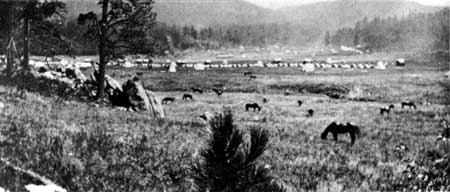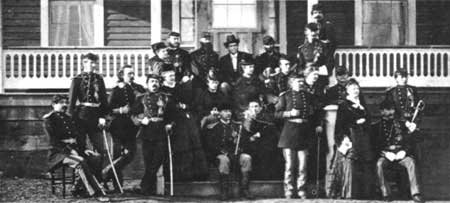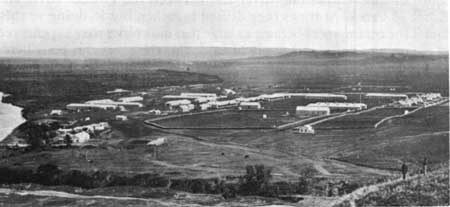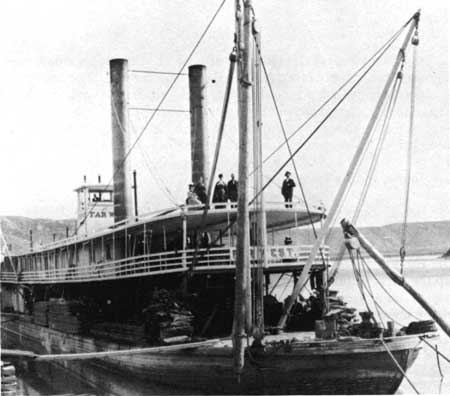|
LITTLE BIGHORN BATTLEFIELD National Monument |
 |

Permanent camp in Custer Valley. Taken during the Black Hills
Expedition, in 1874, by Illingworth.
(Courtesy of the National
Archives.)
The Expedition Against the Indians
The immediate cause of the campaign of 1876 was the Government's order of December 3, 1875, directing that all Sioux be notified "that unless they shall remove within the bounds of their reservations (and remain there) before the 31st of January next, they shall be deemed hostile and treated accordingly by the military force." It was practically impossible for the Indians to comply with this order because of the limited time allowed and the extreme winter weather at that time. Inasmuch as the Indians failed to comply, on February 7, 1876, the Secretary of the Interior and the General of the Army gave Lt. Gen. P. H. Sheridan authority to commence operations against the hostile Indians.
The plan of this campaign was to march into the hostile Indian territory with three separate expeditions from different directions. In the spring of 1876, a military force under the command of Brig. Gen. George Crook moved northwest from Fort Fetterman, Wyo. Gen. Alfred H. Terry, Commander, Department of the Dakota, and in charge of the operations to the north, organized two separate columns. Gen. John Gibbon, with a force of cavalry from Fort Ellis, Mont., and infantry from Fort Shaw, Mont., started in April and moved slowly east down the Yellowstone River. General Terry started from Fort Abraham Lincoln, Dakota Territory, on May 17, 1876, with two companies of the Seventeenth United States Infantry, one company of the Sixth United States Infantry, and the entire Seventh United States Cavalry, numbering in all about 925 men. Gen. George A. Custer and his Seventh United States Cavalry headed the column as it left the fort at the beginning of the westward march.

Group of Seventh Cavalry officers and ladies taken
at Fort Lincoln shortly before the regiment left for the Little Bighorn
campaign. The third officer from the left is General Custer, while Mrs.
Custer is the first lady from the left on the lower step.
(Photograph by D. F. Barry.)

A view of Fort Lincoln, Dakota Territory, from
which General Custer and his command operated from 1873 until the ill-fated
battle in 1876.
(Photographed in June 1877 by Frank Jay Haynes
and used with the permission of Haynes Inc., Yellowstone National Park,
Wyo.)
Slowly this column made its way to the mouth of the Powder River on the Yellowstone. Here, near the present site of Terry, Mont., a base of supply was established and left under guard of the infantry troops. All wagons were abandoned, and from there the supplies were carried by pack mule. The Seventh Cavalry continued up the Yellowstone, arriving at the mouth of the Rosebud Creek about noon on June 21.
General Gibbon's column, under General Terry's instructions, had previously moved down the Yellowstone River as far as the Tongue River, where Miles City, Mont., is now located, but had returned to camp at the mouth of the Rosebud, now Rosebud, Mont., awaiting the approach of the column from the east. Early on June 21, Terry ordered Gibbon's column to begin the march up the Yellowstone again while General Gibbon remained behind for a conference with the other officers.
The steamer Far West, loaded with supplies, was at the Rosebud too. Terry had used the boat for his headquarters and as a means of keeping in contact with both columns. On the afternoon of June 21, Gibbon, Custer, and certain subordinate officers went on board with Terry to discuss future movements. After all available information was considered, General Terry outlined the plan to be followed. General Gibbon's troops were to go back up the Yellowstone, cross to its south side, and march up the Bighorn River and then up the Little Bighorn River. The steamer Far West would follow these streams as far as it could go. General Custer would lead his Seventh Cavalry up Rosebud Creek, following a broad Indian trail reported by Maj. Marcus A. Reno and his scouting troops. The objective was to get the Indians between the two forces and compel them to fight, should they be inclined to run away from a pitched battle, as Indians were reputed to do.

Steamer "Far West," General Terry's headquarters during the
campaign of 1876. This boat carried the wounded in Reno's command back
to Fort Lincoln.
(Courtesy Haynes Inc., Yellowstone National Park,
Wyo.)
Custer's men spent the morning of June 22 preparing for departure. The pack mules were laden with boxes of ammunition; food rations for 15 days, principally hard bread, coffee, sugar, and bacon; and, at Custer's suggestion, an extra supply of salt was packed in the event, through necessity, they should be compelled to live on horse meat. Each man was supplied with 100 rounds of carbine ammunition and 24 rounds of pistol ammunition to be carried on his person and in his saddle bags. He also was to carry on his horse 12 pounds of oats.
By noon, all preparations were completed, and at the sound of "Forward" the regiment moved out of camp. They passed in review before Generals Terry, Gibbon, and their own commander, Custer; then began their march up the Rosebud Creek. Terry and Gibbon on board the Far West proceeded to overtake Gibbon's column which had started up the Yellowstone the preceding day.

|
|
Last Modified: Sat, Sep 28 2002 10:00:00 pm PDT |


